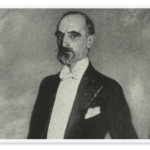A brief history of BBVA (IV): The start of the 20th Century
The end of the colonial conflicts and their consequences opened the door to a new century with various sectors of Spain’s privileged classes showing renewed interest in the creation of new banks. Madrid, Barcelona and Bilbao continued to be the country’s main banking hubs, although the development of the financial industry’s business varied in each region.

In addition to the creation of Banco de Vizcaya in 1901, and the merger of the Banco de Comercio with the Bank of Bilbao, the passage to a new century welcomed other banks with significant capital. For example, the Banco Hispano Americano was established in 1900, followed by the Banco Español de Crédito in 1902. Both got their start in Madrid in a clear sign of the rise of this type of business in Spain after losing the colonies. It was a logical response to the needs emerging from industrial growth and the new prevalence of hydropower.
In Bilbao, the financial center included Banco de Bilbao, Banco de Comercio, Banco de Vizcaya and the Minera Credit Union. While Biscay focused on industrial investments, the Banco de Bilbao continued tied to rail road companies and also bet on industry, especially on shipping, given the group’s new status with the Banco de Comercio. Meanwhile, the Minera Credit Union focused on mining and industry.
During this time, these institutions sought to expand as much as possible in their area of influence by creating agencies out of their savings banks. The Banco de Bilbao had an office in Paris since 1902 but it was the Banco de Vizcaya that marked the start of expansion to towns in Biscay, practically since it was first established. The Banco de Bilbao took a little longer to move in this direction, but both saw the opportunity of becoming financial agents and facilitators of business outside of Bilbao.
In the second decade of the century, Argentina’s Banco Español del Río de la Plata set up offices in Bilbao and San Sebastian, as well as in Galicia, Catalonia and Levante, sending a clear signal that the timid foreign presence of the past was starting to intensify. The new scenario concerned Bilbao’s financial managers to the extent that they decided to appeal to the government, arguing that foreign banks benefited from privileges in Spain.

Months before World War I broke out, business was booming in the country. Spaniards’ significant investments in foreign securities started to be affected by the pre-Ward atmosphere, leading to considerable losses. As a result, a substantial portion of portfolio assets were liquidated, banks increased their reserves due to the uncertainty and money grew scarce due to the increasing demand. Trade was eventually impacted because discount and credit interest rates increases.
With the Great War underway, there was a period of fear and concern that only started to dissipate when citizens confirmed that they had access to liquid money thanks to banks’ efforts to ensure much more cash was available than normal. At the same time, Spain had the comparative advantage of neutrality in the war compared to other neighboring countries. The fact that it did not participate in the conflict meant a significant increase in foreign demand for goods, giving a major boost to the economy. Furthermore, the government also dramatically increased fiscal protectionism of imports, further increasing internal demand.
In 1916, Spain had 47 retail banks – a number that would increase considerably in the second half of the decade. Spain’s strong economy, with industry, mining and shipping booming, meant that just five years later, in 1921, there would be 93 banks. Along the way, in 1919, one of the country’s most relevant banks, Banco Central, weas established. In 1923, the Spanish banking system included 91 institutions with a respectable capitalization of 459 million pesetas.
Madrid and Bilbao were the country’s top financial centers without a doubt due to their dynamic industries. Barcelona took third place. Banks did not do as well there during this period because while banks based in Madrid and Vizcaya had bet on promoting and financing industry from the start, in Catalonia they had focused on deposits and were therefore more affected by the crises of 1898 and 1914.
The Cambó law
On December 28, 1920, it was discovered that Catalonia’s most important bank, Banco de Barcelona, had suspended payments. This was approved the next day at the bank’s Annual General Meeting. In 1922, the bank disappeared. The fatal news that day in 1920 also impacted the Catalan banking system, leading to a bank run where massive amounts were withdrawn from bank deposits, payment suspensions and a clear loss of confidence in banking.

Francisco Cambó i Batlle
This unpleasant episode put Finance Minister in Maura’s government, Francisco Cambó i Batlle, on alert. He therefore decided to promote the Banking Law of December 29, 1921. It would go down in history as the law Cambó drafted, processed and approved at record speed because the Bank of Spain’s 40 year monopoly on issuing currency, granted by Echegaray in 1874, was expiring.
The main goals of this new law included the following:
- Safeguard and intervene in bank credit on behalf of the government through the Bank of Spain;
- Coordinate and centralize the banking business of the newly created High Council on Banking;
- Exclude foreign banks, which held 25% of the banking business in Spain, from the rediscount policy’s bonus scheme – which practically condemned them to disappear; and
- Prevent the Bank of Spain from exercising competency over private retail banks and ensure that it focuses solely on monitoring, coordinating, organizing and strengthening the financial system.
Before the Cambó Law, banks carried out their business freely and could establish banks, merge with other banks and carry out any operation they wanted for fees they considered appropriate. In the words of Minister Maura, Spanish banks “were operating with an exaggerated individualistic spirit. We could almost call it anarchy.” Banks were “not very focused and lacked technical skills” and were facing fierce competition from foreign banks, which were impeding Spanish banks from expanding.